Setting up for a holiday picture is easy. Just get out the camera, put it on a tripod, line up the family, set the self-timer, and run like h%## to get into the picture. Then you’re done, right?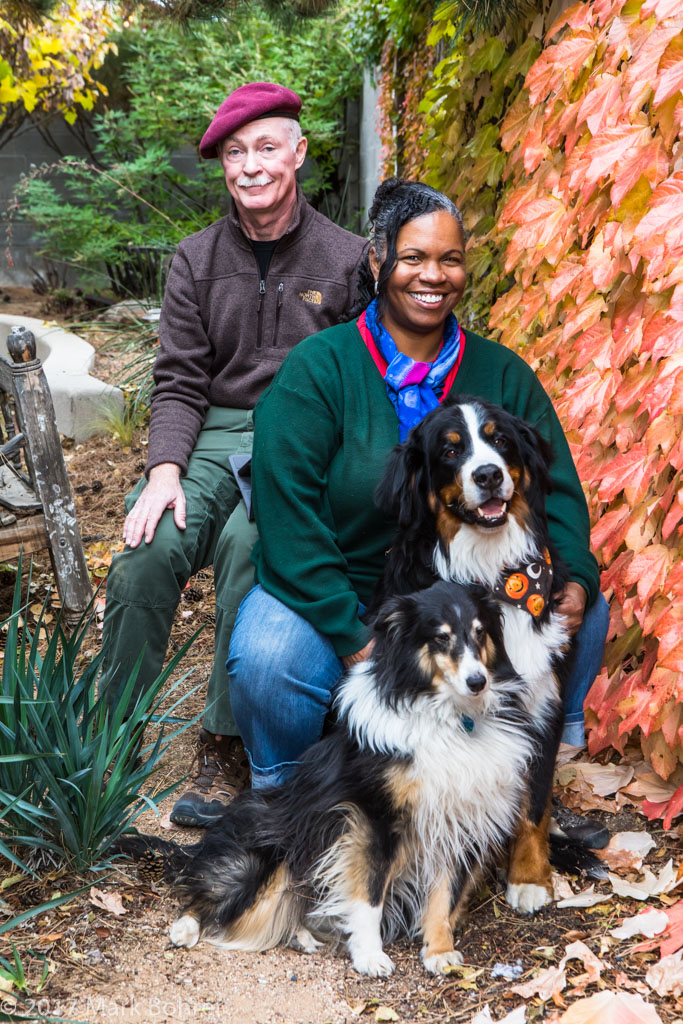 Alternate position without flash In iPhone-savvy, WiFi-connected 2017, it’s a bit more complicated, as I discovered. Find a Good Background First, remember it’s not an execution. Pictures will be lots better if your subjects enjoy themselves. And part of that is preparing most of it in advance. You’ll need a background that says “sense of time and place” without distracting from subjects. Something repetitive with muted colors is perfect. 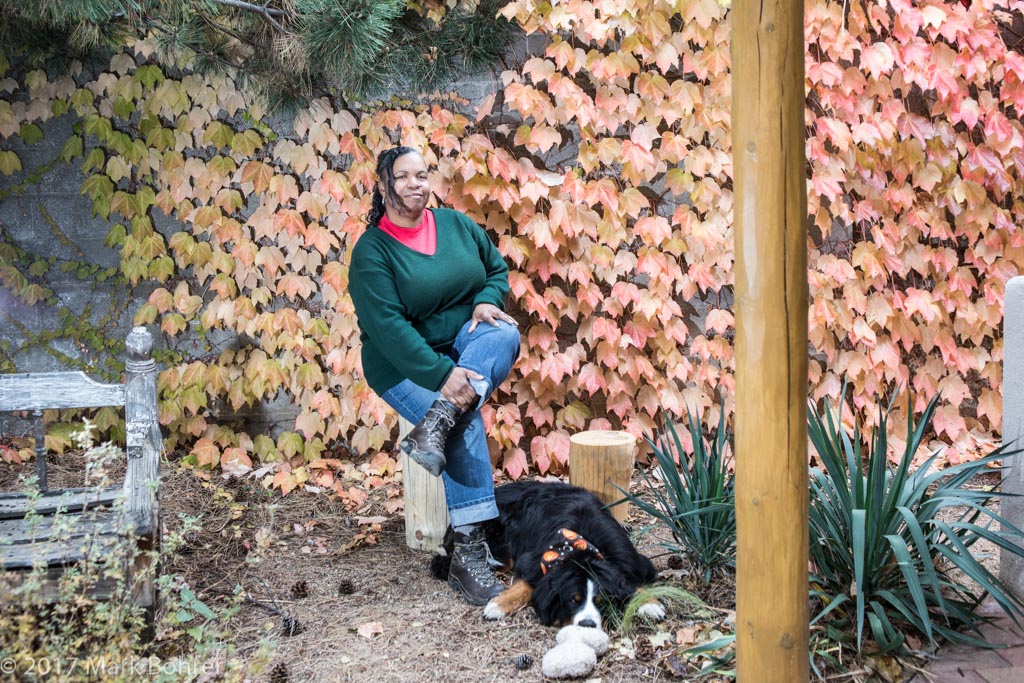 The venue-limited space with ramada at right and decorative (but dilapidated) bench at left Our backyard’s retaining wall is covered with English ivy. Its autumn leaves made a soft, repetitive red-yellow covering – a perfect backdrop. The only challenge was limited area between the wall and an outdoor ramada in the space with the best light. To Flash or Not To Flash – Where’s That Trigger? The cloudy-day light looked great on the background, but I wanted more of a spotlight effect on us, without overdoing it. I hauled out flashes and lightstands, remote trigger receivers and… where was the remote transmitter? And where was one of my two 430EX III RT flashes? I’d used them less than a week ago to shoot Leica camera gear for last week’s post, so I knew they were somewhere in the house. I tore up my office, looked in the bedroom closet, checked my usual hidey-holes in the RV – and no remote transmitter. So I pulled out the previous generation RadioPopper JrX transmitter and set up a tripod-mounted EOS 5D mk IV. I placed one of my old 430EX I’s and the 430EX III RT I could find on stands. The JrX transmitter had been less than reliable when it was my primary remote transmitter. Varying remote flash output power from it tended not to work, so I set power manually at the flashes and set it to trigger only. The JrX transmitter only fits an SLR. Its antenna bump hits any flat-topped camera (think Leica M or Fuji XE-2) and prevents you from sliding it into the hot shoe. So I mounted the EOS 5D mk IV with EF 24-70mm f/2.8L on the tripod, and zoomed the lens to 32mm. Fire That Shutter Wirelessly The next trick was setting up wireless photography. The 5D mk IV has built-in WiFi, which I’d previously used to transfer pictures to an iPhone, so I knew it worked for that. The Cascable app allowed the wireless transfer, and it also gave complete remote camera control. Once I connected the camera to the iPad and app and tested the remote viewing and control, I thought I was set. Where Are They Gonna Sit? Placing your subjects is the next step. For just two adults and two dogs, I figured my task was a little easier. One of us sat on a stump/stool. We thought another taller stump/table would work for the other person, but it turned out to be too much of a seated height difference. So I grabbed my collapsible REI campstool instead. Finally, we had a height match. The biggest challenge in any group shot is getting everyone to look good at the same time. It’s usually pretty easy for small groups of humans. You face them the way you want, tell them to smile and move their heads back and up, then cue them right before you take the shot. 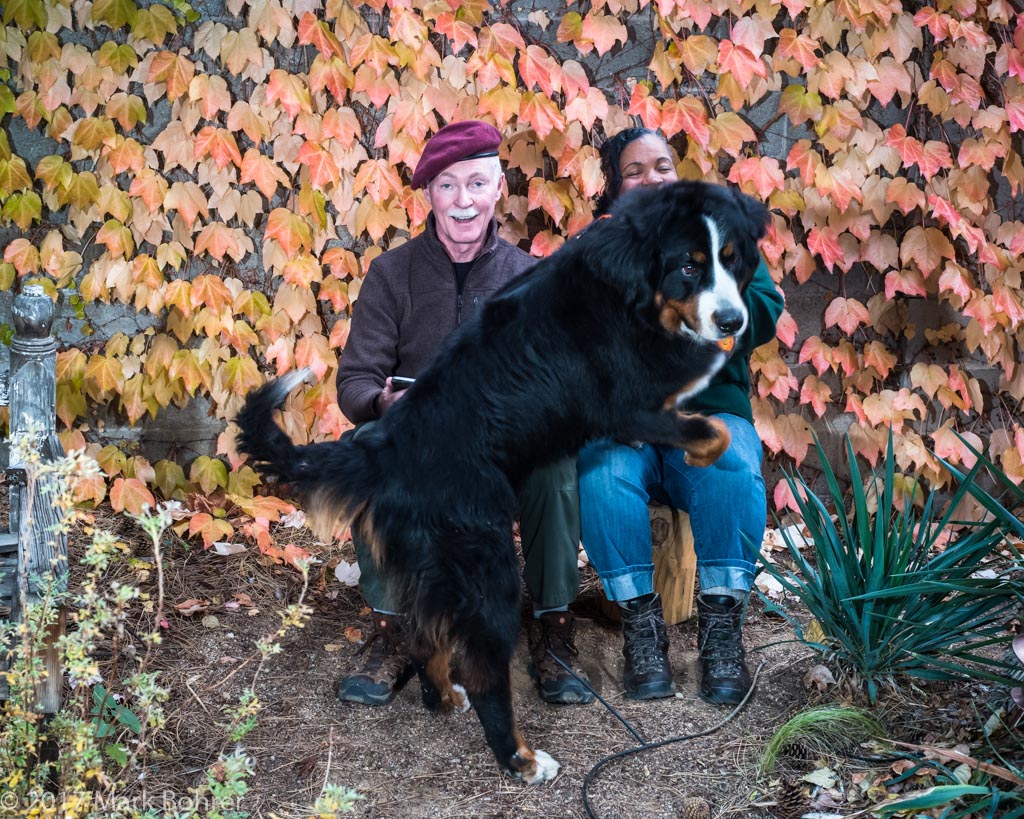 Berner Daisy not posing… At first, the equipment worked fine. But our two dogs weren’t cooperating. They wanted to look anywhere but at the camera. Finally we held them between our knees facing the camera. I just about went insane trying to pick moments of good poses, look back up, and tap the right spot on the iPad’s touch screen to take the picture. Then I waited through the default 4 second delay to see the picture on the iPad. If this sounds a bit painful, it was. But it was about to get worse. 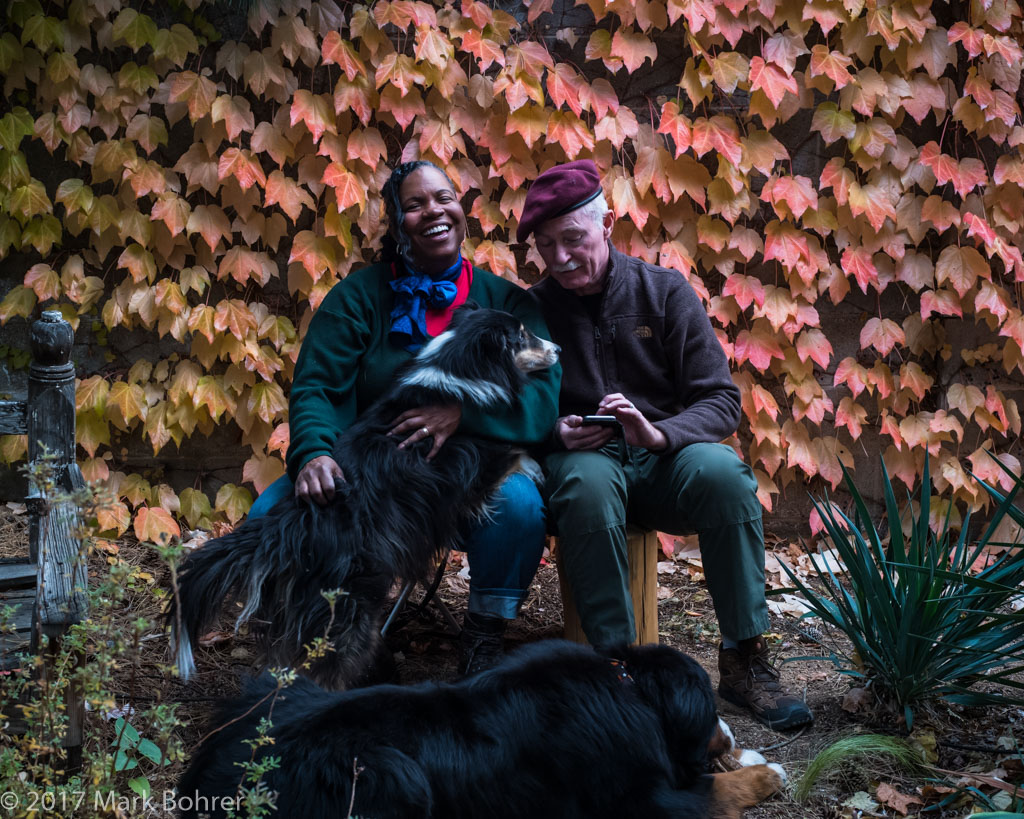 No flash… The flash decided to stop triggering repeatably. Finally it wouldn’t trigger at all, no matter how I wiggled it around or swapped batteries. At that point I muttered several unprintable words and gave up on flash. I shot a few pictures from a different position, sun behind the camera, no flash, but wasn’t happy with the result. Then I decided to check one more place for the missing gear. 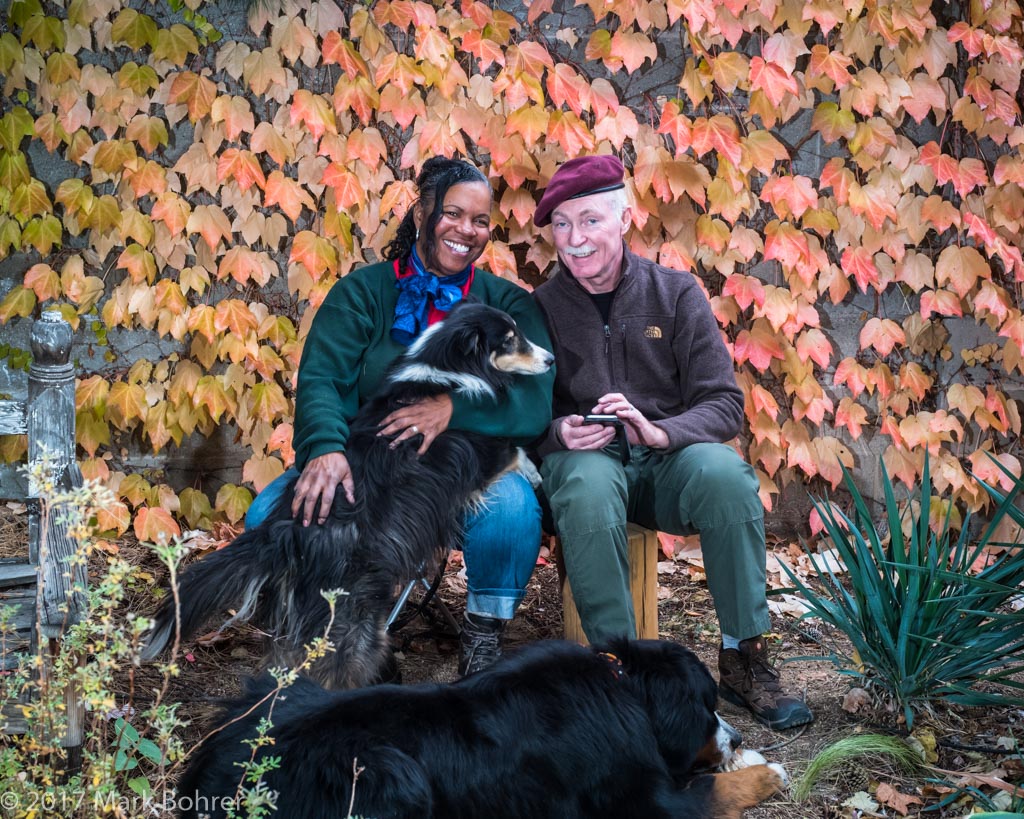 Flash working! I don’t know why I left them there, but the missing transmitter, 430EX III RT flash, and memory card wallet were all in my emergency first aid backpack, in an outer pocket. I’d taken them out of a holster case I left in the car before guiding friends around Kasha-Katuwe Tent Rocks 6 days earlier. We took our friends to Albuquerque’s airport the next morning, then drove 250+ miles for a concert in El Paso that night. It was little wonder I forgot where they were. 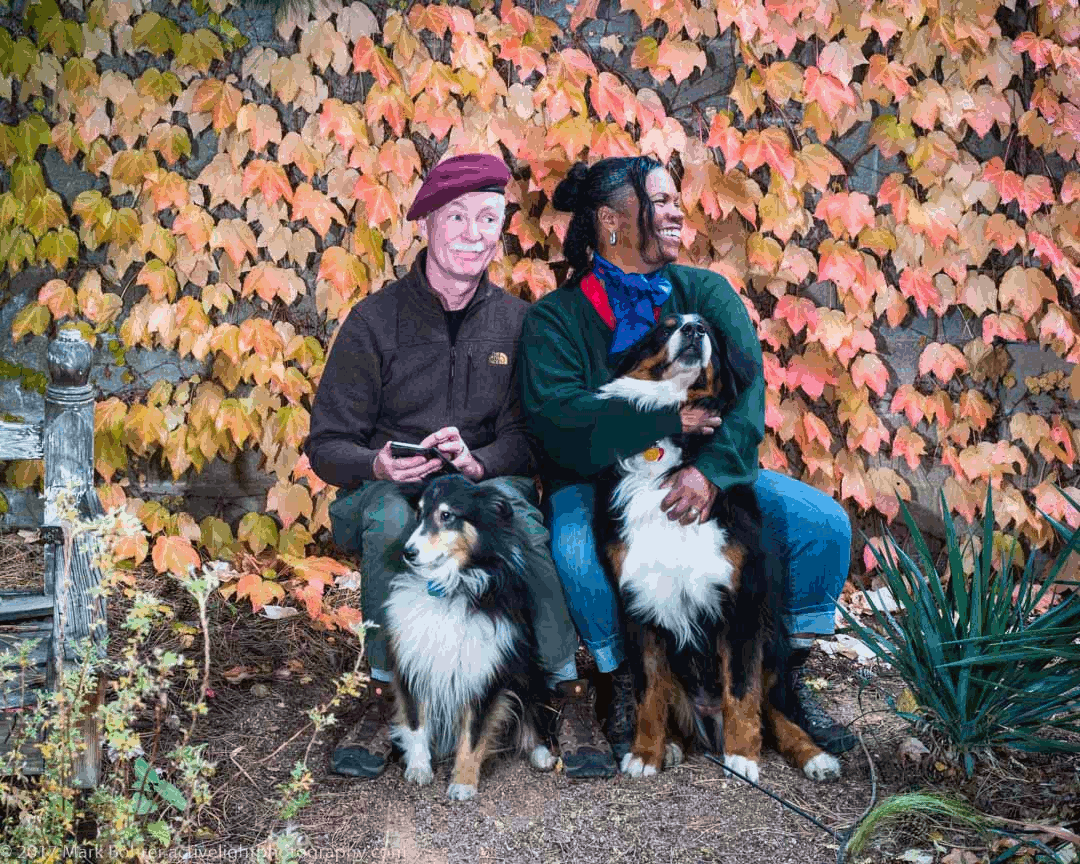 Silly subjects – GIF made from two still frames in GIMP program Take Two So I set both 430EX III RT flashes for E-TTL to allow the RadioPopper Jr2 to control their power, and placed them on their stands and my Leica M10 with 35mm f/2 RF (goggled) Summicron on a tripod. The lens is manual focus only, so I focused on my wife Pat’s eyes and stopped down to f/5.6 to get all of us sharp. I tested the Leica M remote trigger and viewing app on my iPhone after making the connection with the M10’s WiFi. 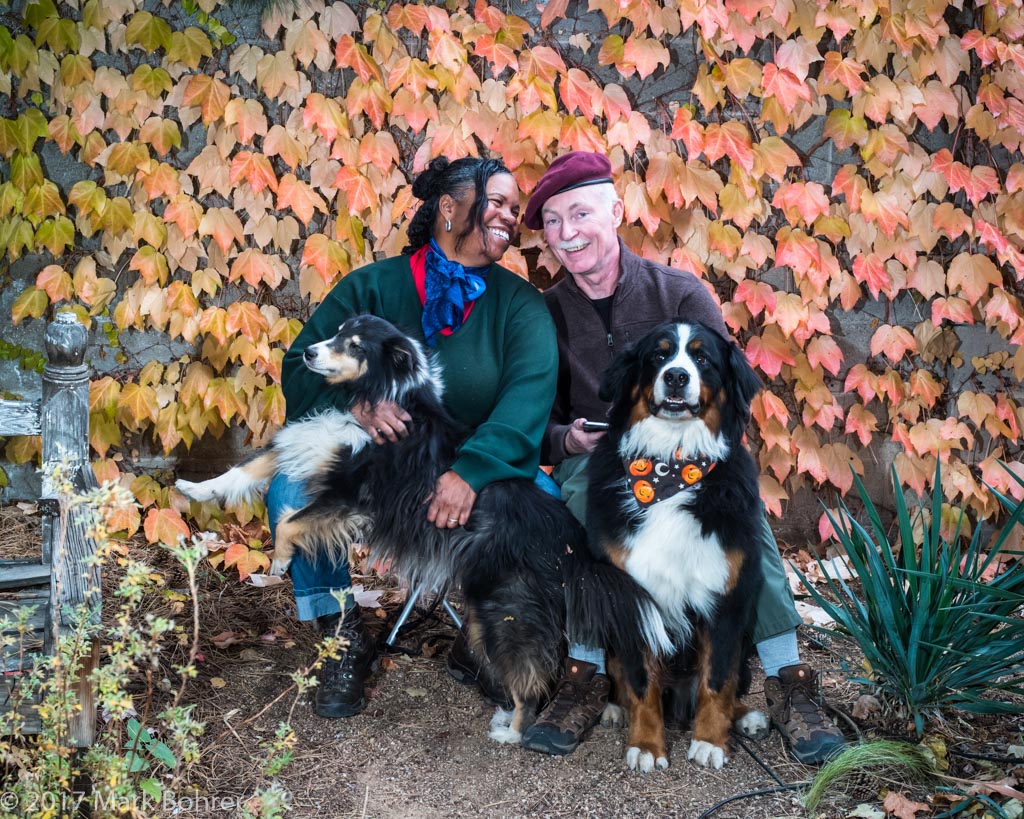 One of the best shots After once again corralling squirmy pups, we got a few good shots. The background light finally started to go around 5:30, so we stopped. After all the trials and tribulations, the little session had ended up fun. 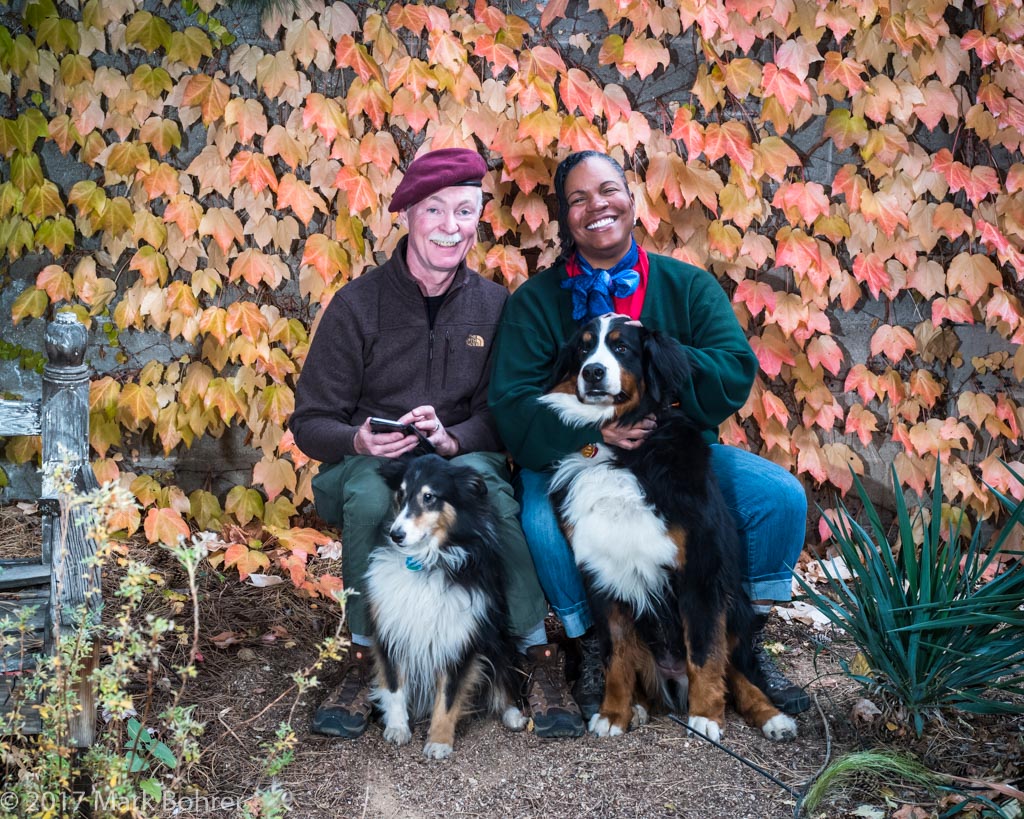 Our favorite Shot Notes Flash and Trigger Choices Canon’s 430EX III RT flashes are small, powerful and relatively inexpensive. They’re also more reliable than Chinese clone flashes. And they support Canon’s E-TTL through-the-lens flash metering. That feature also lets you vary their power in 1/3 stop (EV) increments at the camera with RadioPopper’s Jr2 RF remotes. Manfrotto’s 3373 lightstands are light and fold up small, to less than a 20 inch length. RadioPopper Jr2 receivers screw into their standard 1/4″ studs. I set main light flash power at EV 5.7 (camera right) and second light farther away with power at EV 4.0 (camera left). Both flashes had warming covers and diffusers filtering their light. Along with low-angle sunlight through a cloudy sky, that gave me some spotlighting of subjects and diminished background shadows. Could I have cleaned up the paraphernalia by our feet in the pictures? Yes. Could I have lit better / more directionally? Yes, but by the time I got things working, I just wanted to get it done before sunset. I also could have used my old Canon ST-E2 infrared flash trigger. But its battery was dead, and I don’t 100% trust infrared remotes. It’s also harder to set flash power with it.  Light and camera setup RadioPopper Jr2 flash trigger on Leica M10 not shown; Flash power reduced for setup photography. Camera and Lens Choices Any modern camera / lens combo would have worked for shooting, so long as the camera supported WiFi. (The other option is using another wireless trigger and receiver controlling the camera’s exposure button.) I first set up with a Canon EOS 5D mk IV and 24-70mm f/2.8L zoomed to 32mm. But my preference is the Leica M10 and 35mm f/2 RF Summicron, a lens design from 1958. The M10 faithfully reproduces the sharp-enough drawing of the Summicron, which also gives sharper corners than the 24-70mm zoom. Leica’s 35mm f/2 Summicron-M ASPH is even sharper all the way to the corners – almost clinically. Mine happened to be at Leica USA for repair, so I didn’t have that option. I shot relatively loose since I couldn’t be 100% sure of my own or the dogs’ placement in the frame. With a lens this wide or wider, it’s important to leave enough distance between subject and camera, with about the same distance to all subjects. Daisy’s head is closer to the camera and as a result looks unnaturally large in the shot of “Berner Daisy not posing.” The worst gotcha using either camera was setting up the direct (ad hoc) WiFi connection with iPhone or iPad. When there’s a long time between shots, cameras become more fidgety about staying linked. I had to go multiple levels into each camera’s menus just to connect up. After messing around with the shoot for most of a day, I was happy to get something informal and useful. More importantly, my wife Pat liked the pictures too. More Information The RadioPopper Jr2, retrieved from http://www.radiopopper.com/jr2 Leica M10 Review: Shooting with Leica’s New 24MP Rangefinder Digital Camera in Berlin, retrieved from http://tinyurl.com/ycgmk74m Leica 35mm f/2 LEITZ SUMMICRON 8 Element (1958-1974), retrieved from http://kenrockwell.com/leica/35mm-f2-8-element.htm Canon Speedlite 430EX III-RT Flash Review, retrieved from https://www.the-digital-picture.com/Reviews/Canon-Speedlite-430EX-III-RT-Flash.aspx |
(408) 483-3782
Curious about how to shoot ruins?(408) 483-3782

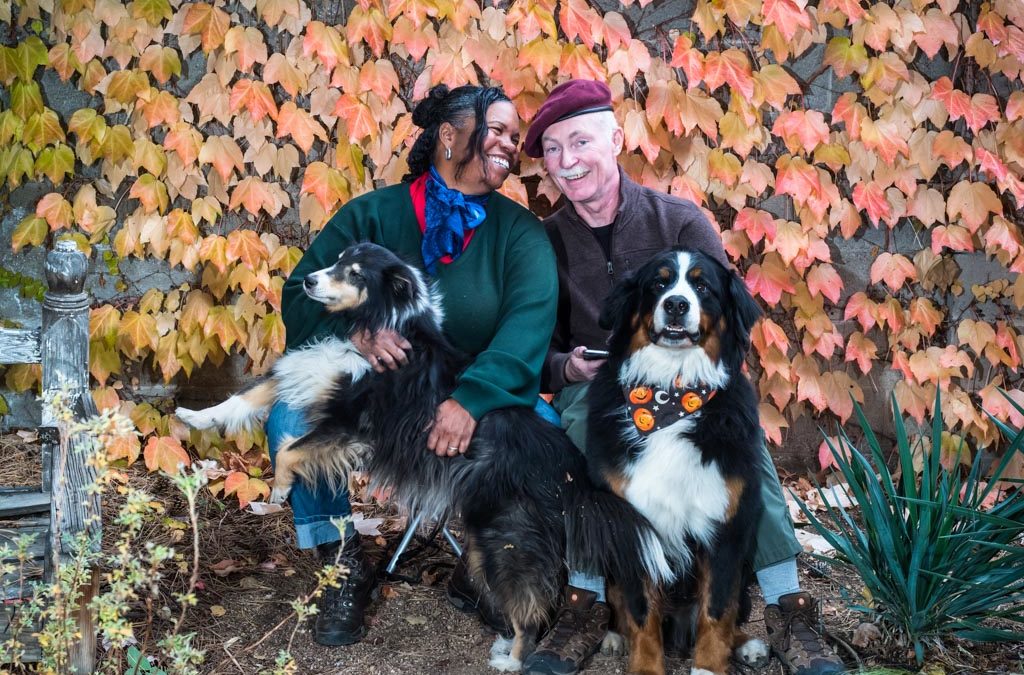
Recent Comments